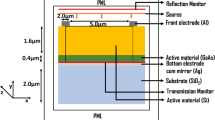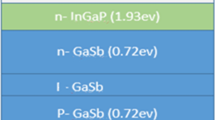Abstract
Optimizing the physical and chemical properties of each material in the solar cell is an efficient way to improve their performance. In the present work, we propose a double layer absorber made of high and low bandgap materials such as gallium arsenide (GaAs) and silicon (Si) along with the window layer made of zinc oxide (ZnO) and buffer layer made of cadmium sulfide (CdS) material. The solar cell structure is numerically optimized for several parameters like thickness of different layers, doping concentration, and operating temperature. Results showed that the open-circuit voltage (Voc), short-circuit current density (Jsc), fill factor (FF), and efficiency (ƞ) are greatly improved against respective changes in the performance parameters. Eventually, a comparison has been made with previously reported solar cells, which proves that our suggested model exhibit high values of Voc = 0.776 V, Jsc = 38.46 mA/cm2, FF = 85.49%, and ƞ = 25.53%, respectively, with almost flat and near unity response for quantum efficiency. This indicates that the proposed design shows promise as a feasible choice for replacing less efficient conventional solar cells.






Similar content being viewed by others
References
K. Yoshikawa et al. Silicon heterojunction solar cell with interdigitated back contacts for a photoconversion efficiency over 26%. Nature Energy 2(5), 17032 (2017)
S. Zhu et al., Transparent electrode for monolithic perovskite/silicon-heterojunction two-terminal tandem solar cells. Nano Energy 45, 280–286 (2018)
J. Werner et al., Efficient monolithic perovskite/silicon tandem solar cell with cell area> 1 cm2. J. Phys. Chem. Lett. 7(1), 161–166 (2015)
Y. Jiang et al., High efficiency multi-crystalline silicon solar cell with inverted pyramid nanostructure. Sol. Energy 142, 91–96 (2017)
C.D. Bailie et al., Semi-transparent perovskite solar cells for tandems with silicon and CIGS. Energy Environ. Sci. 8(3), 956–963 (2015)
C.-H. Chiang, C.-G. Wu, Bulk heterojunction perovskite–PCBM solar cells with high fill factor. Nat. Photonics 10(3), 196 (2016)
N. Gasparini et al., Designing ternary blend bulk heterojunction solar cells with reduced carrier recombination and a fill factor of 77%. Nat. Energy 1(9), 16118 (2016)
C.T. Trinh et al., Potential of interdigitated back-contact silicon heterojunction solar cells for liquid phase crystallized silicon on glass with efficiency above 14%. Sol. Energy Mater. Sol. Cells 174, 187–195 (2018)
K.A. Bush et al., 23.6%-efficient monolithic perovskite/silicon tandem solar cells with improved stability. Nat. Energy 2(4), 17009 (2017)
N. Chuchvaga et al., Study and optimization of heterojunction silicon solar cells. J. Phys. Conf. Ser. 993(1), 012039 (2018)
G. Kaur, A. Mitra, K. Yadav, Pulsed laser deposited Al-doped ZnO thin films for optical applications. Prog. Natural Sci. Mater. Int. 25(1), 12–21 (2015)
B. von Roedern, How do buffer layers affect solar cell performance and solar cell stability? MRS Online Proc Library Arch 668 (2001)
C. Schwartz et al., Electronic structure study of the CdS buffer layer in CIGS solar cells by X-ray absorption spectroscopy: Experiment and theory. Sol. Energy Mater. Sol. Cells 149, 275–283 (2016)
K. Bertness et al., 29.5%-efficient GaInP/GaAs tandem solar cells. Appl. Phys. Lett. 65(8), 989–991 (1994)
K. Chopra, P. Paulson, V. Dutta, Thin-film solar cells: an overview. Prog. Photovolt. Res. Appl. 12(2-3), 69–92 (2004)
H. Heriche, Z. Rouabah, N. Bouarissa, High-efficiency CIGS solar cells with optimization of layers thickness and doping. Optik-Int. J. Light Electron Opt. 127(24), 11751–11757 (2016)
H. Heriche, Z. Rouabah, N. Bouarissa, New ultra thin CIGS structure solar cells using SCAPS simulation program. Int. J. Hydrogen Energy 42(15), 9524–9532 (2017)
M.S. Shur, Handbook series on semiconductor parameters. Vol. 1. 1996: World Scientific
E.H. Nicollian, J.R. Brews, E.H. Nicollian, MOS (metal oxide semiconductor) physics and technology (1982: Wiley, New York et al, 1987)
Y. Liu, Y. Sun, A. Rockett, A new simulation software of solar cells—wxAMPS. Sol. Energy Mater. Sol. Cells 98, 124–128 (2012)
M. Burgelman, P. Nollet, S. Degrave, Modelling polycrystalline semiconductor solar cells. Thin Solid Films 361, 527–532 (2000)
J. Pala et al., Analysis and design optimization of organic dye sensitized solar cell based on simulation. AIP Conf. Proc. 1837(1):030004 (2017)
R. Stangl, C. Leendertz, J. Haschke, Numerical simulation of solar cells and solar cell characterization methods: the open-source on demand program AFORS-HET. In: Solar Energy. 2010, InTech
S. Degrave, M. Burgelman, P. Nollet. Modelling of polycrystalline thin film solar cells: new features in scaps version 2.3. In: Photovoltaic Energy Conversion, 2003. Proceedings of 3rd World Conference on. 2003 1, 487–490 (2003) IEEE
H. Movla, Optimization of the CIGS based thin film solar cells: Numerical simulation and analysis. Optik-Int. J. Light Electron Opt. 125(1), 67–70 (2014)
M. Burgelman et al., Modeling thin-film PV devices. Prog. Photovolt. Res. Appl. 12(2-3), 143–153 (2004)
M. Liu, M.B. Johnston, H.J. Snaith, Efficient planar heterojunction perovskite solar cells by vapour deposition. Nature 501(7467), 395–398 (2013)
P. Chelvanathan, M.I. Hossain, N. Amin, Performance analysis of copper–indium–gallium–diselenide (CIGS) solar cells with various buffer layers by SCAPS. Curr. Appl. Phys. 10(3), S387–S391 (2010)
A.D. Khan, J. Iqbal, S. ur Rehman, Polarization-sensitive perfect plasmonic absorber for thin-film solar cell application. Appl. Phys. A 124(9), 610 (2018)
A.D. Khan et al., Light absorption enhancement in tri-layered composite metasurface absorber for solar cell applications. Opt. Mater. 84, 195–198 (2018)
M. Penny, T. Farrell, G. Will, A mathematical model for the anodic half cell of a dye-sensitised solar cell. Sol. Energy Mater. Sol. Cells 92(1), 24–37 (2008)
X. Miao et al., High efficiency graphene solar cells by chemical doping. Nano Lett. 12(6), 2745–2750 (2012)
T. Nakada, M. Mizutani, 18% efficiency Cd-free Cu (In, Ga) Se2 thin-film solar cells fabricated using chemical bath deposition (CBD)-ZnS buffer layers. Jpn. J. Appl. Phys. 41(2B), L165 (2002)
C.S. Solanki, Solar photovoltaics: fundamentals, technologies and applications. PHI Learning Pvt. Ltd (2015)
D. Braunger et al., An 11.4% efficient polycrystalline thin film solar cell based on CuInS2 with a Cd-free buffer layer. Sol. Energy Mater. Sol. Cells 40(2), 97–102 (1996)
N. Amin et al., Numerical modelling of ultra thin Cu (In, Ga) Se2 solar cells. Energy Proc. 15, 291–298 (2012)
S. Komilian, O. Oklobia, T. Sadat-Shafai, Controlling intercalations of PBDTTT-EFT side chain to initiate suitable network for charge extraction in PBDTTT-EFT: pc 71 BM blended bulk heterojunction solar cell. Sol. Energy Mater. Sol. Cells 175, 35–40 (2018)
K. Qiu et al., Power-loss analysis of a dopant-free ZnS/p-Si heterojunction solar cell with WO 3 as hole-selective contact. Sol. Energy 165, 35–42 (2018)
Y. Takano, K. Oyaizu, Fabrication of SnS-MgSnO heterojunction solar cells using vacuum thermal evaporation and sol-gel method. Materials Letters, 2018
J. Zheng et al., 21.8% efficient monolithic perovskite/homo-junction-silicon tandem solar cell on 16 cm2. ACS Energy Letters 3(9), 2299–2300 (2018)
J.-H. Wi et al., Spectral response of CuGaSe 2/Cu (In, Ga) Se 2 Monolithic tandem solar cell with open-circuit voltage over 1 V. IEEE J. Photovolt. 8(3), 840–848 (2018)
Author information
Authors and Affiliations
Corresponding author
Rights and permissions
About this article
Cite this article
Khan, A.D., Khan, A.D. Optimization of highly efficient GaAs–silicon hybrid solar cell. Appl. Phys. A 124, 851 (2018). https://doi.org/10.1007/s00339-018-2279-9
Received:
Accepted:
Published:
DOI: https://doi.org/10.1007/s00339-018-2279-9




